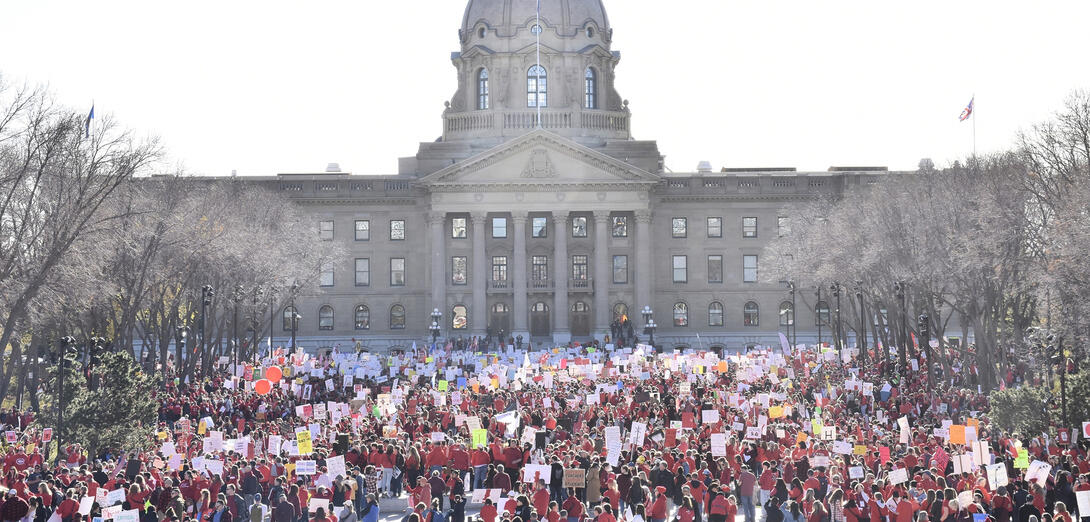Question: Why isn’t the Association paying its members strike pay?
Answer: There are several layers to this question, depending on who is asking it. There are bad actors in social media who are raising the issue with the malicious intent of driving a wedge between teachers and their association. Often, they will provide inaccurate information about Association finances to further their mischief. So, let’s start from the beginning and that means a trip into history, my favourite sort of trip!
The Special Emergency Fund (SEF) was established in 1952, long before the passage of the Public Education Collective Bargaining Act (PECBA), which established bilevel bargaining and made provision for a central table agreement that would cover teachers across the province. At the time, the SEF, which functioned as the Association’s strike fund, was designed to support labour action that involved a few locals at a time. Furthermore, the locals were much smaller and there were many more of them prior to the great amalgamation of school boards in 1995. That meant that the fund needed only to provide a buffer to support a relatively small number of striking teachers at any one time, while the vast majority of their colleagues remained on the job, paying their dues. Strike pay could then be offered and funded on an as-needed basis even as strikes occurred on a more frequent basis. Still, an extended strike by a large local could effectively deplete the fund, as happened when Calgary Public teachers went on strike in 1980 for 44 school days, or when an escalating series of coordinated local strikes in 2002 culminated with approximately two-thirds of the province’s teachers being off the job.
Everything changed, though, with the passage of PECBA in 2015. That amalgamation of boards in 1995 also stripped their capacity to levy taxes and control their revenues, making them entirely dependent upon the provincial government for funding. Come time for negotiating, however, the province was not at the table and teachers were left to converse with proxies, not power. The great advantage of central table bargaining was that the central table negotiation, which included all the significant cost items, would involve the provincial government directly and force it to fund the commitments made in the central table agreement.
However, the other consequence of having a provincial table and provincial agreement was that a failure to reach a bargained agreement could and did lead to a strike involving all the province’s teachers. While there might be the option of running rotating or escalating strike action, these approaches could be thwarted by the government and school boards by going immediately to a lockout. For this, and for other tactical considerations, once strike action became inevitable, Provincial Executive Council (PEC) ruled out anything other than a strike of all teachers, all at once.
So, back to the issue of strike pay. Standing at $25 million, the SEF is insufficient to fund strike pay for all teachers for any length of time in any meaningful amount. The rough math is simple: with 51,000 full-time, part-time and substitute teachers on strike, per-teacher strike pay would total about $490, which, coincidentally, is equivalent to one day’s pay for the average teacher. Administrative and distribution costs would also be substantial. So instead of paying strike pay, PEC committed the entirety of the SEF to cover the cost of maintaining health benefits, with the exception of health and wellness spending accounts, for members throughout the duration of the strike by paying both the member and employer contributions to the benefits providers. This ensured that members would not have to pick up the costs themselves and risk, in the event of nonpayment, a lapse of their benefits coverage. The $25 million in the SEF was sufficient to cover just over two weeks of member benefits, after which the Association has drawn upon its limited cash reserves to maintain these payments on behalf of members.
The short answer, then, to the question “why didn’t the Association provide strike pay?” is that it chose instead to maintain benefits for members. The decision that strike pay would not be available was communicated to members at the multiple member information meetings that have taken place in person and online since May.
By the time this strike is over, the SEF will be fully depleted. If teachers want the fund to be sufficient to provide general strike pay in the future, it would require building an SEF that would be many times larger than has ever existed in the past, paid for by substantially increased fees. While Association staff and PEC will continue to seek whatever operational economies we can over the months ahead, discretionary programing expenditures amount to less than a quarter of the Association’s $50 million annual budget, the remainder being committed to staff salaries, operations and other fixed and inelastic expenditures. It would be practically impossible, and I would argue unwise, to attempt to recoup the funds expended during this strike by slashing Association programming and the discretionary member supports that provide ongoing value to teachers.
Ultimately, teachers will have to determine through the Association’s budget process if the SEF will be replenished, in what amount, for what purpose and over what time period. These complex and important decisions will ultimately be made by over 400 elected teacher representatives meeting at the 2026 Annual Representative Assembly. Detailed information about the Association’s proposed budget and opportunities for input are provided to local representatives beginning in February, and to the general membership in the ATA News in the months preceding ARA, which will take place on the May long weekend.
Questions for consideration in this column are welcome. Please address them to Dennis Theobald at dennis.theobald@ata.ab.ca.

ATA Executive Secretary


